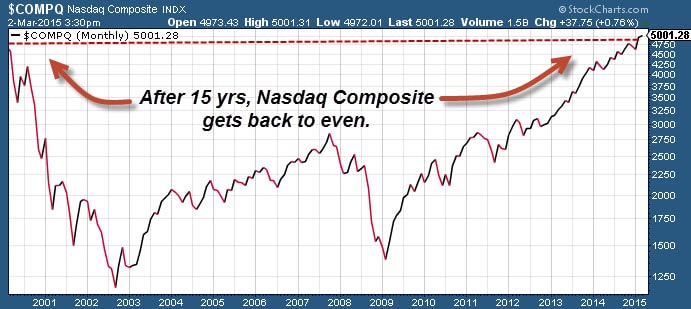Back to the future! The Nasdaq Composite Index (NasdaqGIDS:^IXIC) just crossed 5,000. Other stock market yardsticks like the Dow Jones Industrial Average (NYSEARCA:DIA) and S&P 500 (NYSEARCA:VOO) sit atop multi-year highs too. Everything that is old and worn out is suddenly new and exciting. (See skinny jeans and venture capital.)
All of us are 15 years older since the Nasdaq passed 5,000 the first time, but are we smarter? In case your sense of common (also known as “common sense” in other quarters) isn’t kicking in, here’s a few ageless lessons to help you navigate Nasdaq 5000 (NYSEARCA:QLD).
(Audio) Portfolio Report Card: A Hyper-Aggressive $1.4 Million Investment Plan that Falls Short
Lesson 1: Sell when you can; not when you’re forced to.
If you’re sitting on any highly appreciated assets that have benefit from a rising market, congratulations! You got lucky, you we’re blessed, or both. But paper profits don’t count because real profits only happen when you take them.
When is the best time to sell? Since nobody can agree on the answer, let’s re-frame the question: When is the best time not to sell? Naturally, it’s when you are forced to sell because your investments are a) losing value or b) you need the money. Sell before that happens.
Lesson 2: Risk management happens before the fire.
Properly executed, risk management always happens before the fire. For example, if you own a building, you can’t buy fire insurance after the joint has already burned to the ground. Likewise, the prudent investor protects their portfolio ahead of crisis, not during crisis.
Financial markets fall faster than they rise. The Nasdaq’s bear market (NYSEARCA:QLD) that began in 2000 erased $5 trillion in just 31 months. How long did it take for the Nasdaq Composite (NYSEARCA:ONEQ) recover? 15 years! The people that bought fire insurance 16 years ago instead of 14 were protected.
Lesson 3: Always have a personal margin of safety.
“Margin of safety” is a concept usually applied in the context of selecting individual stocks. What’s your personal margin of safety? Do you know?
For the individual investor, your “margin of safety” represents the capital or money that you absolutely cannot afford to risk to potential market losses. This money gets set aside from your core and non-core portfolio to be invested in fixed accounts with liquidity and principal protection.
Having a personal margin of safety, besides protecting your assets, acts as a psychological buffer. How? It keeps you liquid and dissuades you from disrupting the rest of your investment plan with counterproductive behavior like panic selling, unnecessary trading, and other knee-jerk reactions.
If you’re investing without a personal margin of safety, you’ll be fine up until the godforsaken day when you’re suddenly not. A breadline tells no lies.
In summary, yes Nasdaq 5,000 is just another number. But correctly managing risk is not.
Follow us on Twitter @ ETFguide
